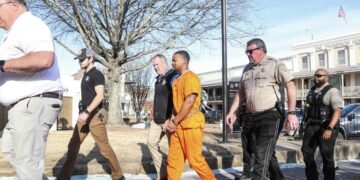The National Trust for Historic Preservation (NTHP) issued a statement last Thursday noting that Confederate monuments “still stand as symbols of those ideologies and sometimes serve as rallying points for bigotry and hate today. To many African Americans, they continue to serve as constant and painful reminders that racism is embedded in American society.”
The statement’s release coincided with the Institutions for Higher Learning (IHL) Board of Trustees finally approving the plan to move the University of Mississippi Confederate monument to the more appropriate location of the campus Civil War cemetery.
Unfortunately, those plans also include the very advancement and celebration of Lost Cause mythology that the NTHP warns us about. It appears that neither the university’s administration nor the IHL understands the history or the stewardship practices of Civil War cemeteries, and instead of reaching out to their own historians for guidance and understanding, they are acquiescing to private individuals who, intentionally or not, are perpetuating the Lost Cause.
The plan submitted by the university administration to the IHL is not simply moving the monument, but it is creating a Lost Cause shrine at the cost of over $1 million dollars, coming from private funds. The plan includes placing hundreds of white granite headstones in the enclosed cemetery. Not only is placing monuments historically inaccurate, it fails to follow past government Civil War cemetery practices, and it is contrary to what the contemporary Oxford citizens desired for the cemetery. The private funds are needed since the U.S. Department of Veterans Affairs, the agency responsible for placing Civil War soldier’s headstones, in 2018, notified the university that they would not place marked individual headstones in a cemetery that has insufficient supporting documents.
Here is what is known about the history of the cemetery. The university served as a hospital for both the Union and the Confederacy. Those who died were buried with wooden headboards marking their graves. Because of lost and incomplete records, we have no idea how many soldiers were buried in the cemetery. The number on the bronze tablet, currently standing at the center of the site, claiming 700 to 800 burials, is inaccurate. This information appears to come from a 1904 article written by former Confederate soldier and then-University of Mississippi Vice Chancellor R.W. Jones. He writes that the original death ledger cannot be found and all that remains is a list — created by the assistant surgeon at the campus hospital — of men who died in his ward.
The search for the original ledger continues, but as of 1904, we only had a partial list. A modern archaeological scan of the cemetery suggests 430 “shafts,” but we do not know if these all contain remains. We do know that after the war, twenty Union soldiers originally buried in Oxford were reinterred at Corinth. The cemetery scan and the records at Corinth do not come close to adding up to the number of dead Jones claimed were interred on campus. The most likely explanation for this discrepancy was a tendency among Lost Cause writers to inflate Union casualties in order to suggest the martial superiority of Southern soldiers. Jones is but one example.
Complicating matters still further, Union soldiers were not the only ones removed, as Southern citizens, with help from post-war Ladies Memorial Associations, located their loved ones and had them removed and reinterred in family or local cemeteries. The fact is we do not know with any certainty which bodies remain or where they are located within – or even beyond – the enclosed area.
This means that, following the National Cemetery Administration’s policies, no names can be etched on the stones, and it is impossible to know how many stones to place or where to place them. Arbitrarily placing hundreds of markers that only read “Unknown” is a complete waste of money and places more of a burden on the already overworked and underpaid university grounds crew.
The issue of not knowing who is buried where in a Civil War cemetery is not unique to Oxford though, and we can apply cemetery stewardship lessons from previous government practices. In the North, approximately 26,000 Confederate prisoners of war were buried on or near where they were once held captive. As with the Civil War cemetery on campus, these sites employed wooden markers and the records of Union prison burials are incomplete. Put simply, Civil War records, in the North and in the South — especially concerning those who died in hospitals and prisons — are spotty. This makes identification at many cemeteries problematic.
The disrepair of hospital and prisoner of war cemeteries led Congress to create the Commission for Marking Graves of the Confederate Dead in 1906. The commissioners were charged with acquiring land where the dead were buried in the North, identifying the dead, creating new records, placing headstones and fences and caring for the burial grounds. Because of the decayed wooden markers and incomplete records, names could no longer be matched with gravesites, so commissioners in numerous sites decided that the best practice was to mark the graves with a central monument and create a bronze tablet that listed the names and units of those who died at a particular location.
The marker currently standing at the center of the cemetery clearly suggests that the same protocol was followed in the cemetery located on the university’s grounds. In fact, in 1909, the Oxford Eagle published a few sentences remarking on the Alton, Illinois, prisoner cemetery monument being erected, which demonstrates Oxford citizens were paying attention to the commission. Local United Daughters of the Confederacy (UDC) chapters assisted the federal commission and were ultimately pleased with the central monuments. In Oxford, the UDC “never deemed it advisable to place blank headstones.”
Why do wealthy donors with no apparent understanding of the stewardship policies of Civil War cemeteries find it necessary to do more than what was done by the United Daughters of the Confederacy, the most powerful group of Lost Cause memorializers in American history? Time after time, university administration has blocked efforts to dismantle systemic racism at the school. We must negate the grip of the Lost Cause – and that includes refusing to proceed with plans to transform the cemetery grounds into a Lost Cause shrine.
Once again, an opportunity for the University of Mississippi to be on the “right” side of racial justice issues is here. The question is: will administration, at last, overrule the bigots?
Beth Kruse is a PhD candidate in the Arch Dalrymple III Department of History and was the 2019-2020 McMinn Fellow at the Center for Civil War Research. Her research focus is Civil War memory and military prisons.

























